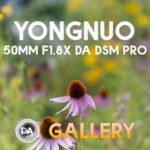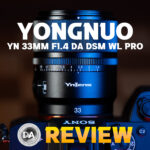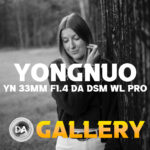
I spent some time earlier this year reviewing the Yongnuo 11mm F1.8S DA DSM wide angle on Sony E-mount. I was impressed with some of the truly unique features and strong performance of the lens. It was enough to give me a positive feeling about the brand, so when Yongnuo reached out to me about a new lens for Fuji X-mount, I happily agreed to spend some time with it. I’ve had about six weeks with the Yongnuo YN 50mm F1.8X DA DSM Pro lens, and in many ways it is a very impressive little lens. It’s got a lot going on for a price tag of about $300 USD, and provides an interesting alternative to the 56mm options on the market with a few more upscale features. You can find out my full thoughts by watching the video review below…or reading on.
Follow Me @ YouTube | Patreon | Instagram | Facebook | DA Merchandise | Flickr | 500px | X
Thanks to Yongnuo for sending me a review sample of this lens. As always, this is a completely independent review. *The tests and most of the photos that I share as a part of my review cycle have been done with the 40MP Fujifilm X-H2 camera.
__________________________________________________________________________________________________
This is an APS-C design that I’ve tested in Fuji X-mount. While there are other versions of this lens available on Sony E-mount or Nikon Z-mount, the Fuji version is the only one to get the unique “Pro” designation due to having some upscale features. It should be noted that there is also a non-Pro 50mm F1.8X DA DSM lens available for Fuji X-mount. That lens is smaller, cheaper, a different optical formula, and has far few features. I’m going to share Yongnuo’s own comparison chart to help you avoid some confusion between these two lenses.

Basically everything about YN 50mm Pro, from the size, feature set, housing material, optical design, and even the angle of view. Still, it’s a little confusing that they have two 50mm F1.8 lenses on X-mount. These lenses are also very different optically, however, with the YN 50mm Pro being superior optically.

That’s extremely important on Fuji, particularly when using it on one of Fuji’s monster 40MP APS-C sensors like the one found in the X-H2 I’m using for the review. Lenses have to be very sharp to look credible on that sensor, but fortunately the YN 50mm Pro does a pretty excellent job of that.

If you don’t speak Yongnuo, let me break down what those letters mean in the 50mm F1.8X DA DSM Pro lens designation. In many ways this follows the Fuji naming convention which puts a list of features right in the name.
- X = Fuji X-mount
- DA = APS-C
- DSM = Digital Stepping Motor
- Pro = Higher end performance and features.
I had a few early quirks between the lens and my X-H2, but fortunately a firmware update completely cleared all of that up and allowed the lens to function fairly close to flawlessly on my camera. I had a lot of fun with the YN 50mm Pro due to a great mix of sharpness and nice bokeh.

There are also a few weaknesses along with many strengths, and we will break down it all in our review.
Build and Handling
50mm isn’t quite as popular on APS-C as it is on full frame, as when you apply the 1.5x crop factor on Fuji to the focal length, you end up with a full frame equivalent of 75mm. I have seen more 75mm lenses in recent years, but obviously the more popular focal length is 85mm, or a 56mm lens on APS-C. There are far more 56mm options on Fuji, though there are a couple of 50mm lenses as well, including the Fujinon XF 50mm F2 WR and the extremely expensive XF 50mm F1.0 WR lenses. Both Fuji options are more expensive than the Yongnuo lens, with the 50mm F2 costing $150 more and the F1.0 lens costing a whopping $1200 more!

You can see from the specifications above that the 50mm F2 lens is smaller and lighter than the YN 50mm Pro, but also lacks its more advanced features.
I keep notes files on my phone to record random field observations when using various gear, and one of the notes I had was that the build of the lens reminded me of a Zeiss Batis lens. This was in part due to the upscale metal construction (an aircraft aluminum alloy) and also the integration of a small LCD screen on the top of the lens.

While the YN 50mm Pro doesn’t have a traditional aperture ring, it does utilize the LCD screen in conjunction with one of the custom settings via a switch on the left side of the barrel to allow the manual focus ring to function as an aperture ring. The LCD readout will show aperture changes in real time to allow you to select your desired aperture.

This feature is perhaps less necessary on a more advanced camera like my X-H2, as that features an LCD readout on top of the camera where I can quickly see the current aperture value (you can see the redundant figures above), but it will be much more useful on the vast majority of Fuji’s cameras which lack a top mounted LCD.
It would have been nice to see this also function as a distance scale when manually focusing (like the Batis lenses).
The size is 68mm in diameter (2.67″) and 85mm (3.34″) in length. The lens weighs in at 387g or 13.65 oz. Up front we have a common 58mm front filter thread.

The lens barrel is made of metal, and it has a nice, anodized black satin finish. The lens design is very clean and modern.

A lens hood is included. While it isn’t anything particularly special, it is sturdier than some and bayonets into place with a reasonably precise feel.



There is a USB-C port for firmware updates covered by a small rubber gasket. Be careful when pulling it out, as it is small and wouldn’t be hard to lose.

The USB-C port will allow for quick and easy firmware updates, which is a smart move by Yongnuo considering that they are a third party lens maker, so they may have to rely on firmware updates to maintain compatibility with cameras in the future. The lens does include a USB-C cable in the box in case you don’t have one. I definitely needed that firmware update to help eliminate a few instabilities in my review copy (these included aperture resets to F16 and the inability to shoot more than one shot in a burst). After the firmware update the lens has operated in a very stable fashion.
There is a metal lens mount with a weather sealing gasket attached. Yongnuo also claims a fluorine coating on the front element to resist fingerprints and moisture.

There is a custom switch that allows for a few different functions, in theory, but in reality only really serves one. In mode 1, it sets the control of ring to aperture control. This works well enough, though the wide, lightly weighted focus ring is fairly easy to bump and cause you to inadvertently change the aperture. I will also note that for some reason the manual aperture change doesn’t seem to work in video mode on my X-H2. I have to control aperture from within the camera.

Putting the switch into Mode II in theory instructs the ring to function as a focus ring, though this does not automatically switch to manual focus. Fuji’s own lenses never have an AF | MF switch, so the whole system is designed for this function to be controlled from the camera, often via a lever. Putting the lens into Mode II means the ring will function as a manual focus ring, but only after you have selected MF from within the camera.
The manual focus ring has a nice feel to it overall, though the weight is on the lighter side. As per usual, I find manual focus a little frustrating on Fuji cameras, as it takes many, many rotations to make major focus changes.

Take a closer took inside and you can see 9 rounded aperture blades, which is a higher blade count than the 7 on the non-Pro model. The aperture shape stays reasonably circular as the lens is stopped down.

The sunstar looks reasonably clean with the aperture stopped down (here at F11), but you can also see from this shot that this is a very flare prone lens.

The minimum focus distance is 45cm and gives a maximum magnification figure of 0.15x, which is good enough to be useful and matches what the XF 50mm F2 offers. Here’s what MFD looks like:

Up close results still look pretty good.

Recent 56mm F1.7/F1.8 lenses from Viltrox and TTArtisan undercut the price tag of the YN 50mm Pro (which can typically be had for under $300), but neither of those lenses are close to matching the build and features of the Yongnuo lens. This is a very nice little lens that feels pretty upscale in the build and handling.
Autofocus and Video
Yongnuo has equipped the 50mm F1.8 with what they call a “digital stepping motor” (DSM). I’m not entirely sure how a digital stepping motor varies from a typical stepping motor, but the end result is a mostly quiet, fast, and accurate focus experience, though with some of the typical Fuji quirks and frustrations. The last time I did a Yongnuo review, it was on Sony, and autofocus is almost always much better there than on Fuji.

Focus noise is quiet, with very little to be heard at a typical shooting distance. If I put my ear right up against the barrel I hear a bit of high pitched whirring and a little clicking.
Focus speed is relatively quick, though particularly in lower light I saw some obvious steps and pulses. Outdoors and in good light autofocus was fairly snappy. For ordinary shots like casual portraits, nature, landscapes, fairly still subjects, I saw very nice accuracy. This shot of Ferrari is a good case in point. You can see note only that the photo is well focused; you can also see that this lens is pretty fantastically sharp.


I was able to shoot narrow depth of field shots with good precision.

I got some good shots at a dog competition, but I got them by prefocusing on the area where the jump would take place rather than trying to just acquire the dogs in movement towards it.

In situations where I tried to track persistent action, I found that focus would move around a bit and was often a little behind where it should be (mid-body rather than face).



The YN 50mm Pro isn’t quite ready for any kind of demanding action.
For most other applications, however, I didn’t have any issues with focus.
Things were (as usual for Fuji) much worse on the video front. As is often the case, I found it nearly impossible to do my focus pull test by touching the point I wanted focus to move to on the screen. Rather than going back and forth, I had to touch the place where I wanted to go and wait…and wait…and sometimes focus would change, though with obvious steps and adjustments. Very frustrating.
The YN 50mm Pro did a little better in my hand test, where I alternately block the camera’s view of my face with my hand and then remove it, but here too focus changes were slow…or just didn’t happen. It was better than the focus pull test, but far from satisfying. I noticed that focus was not consistently on the right place even when focused, however, with some microadjustments. There is also some obvious focus breathing.
Video AF of more typical subjects and movements was better. I tracked a sailboat moving through a harbor fairly well, coneflowers blowing in the wind, and my video footage of a ride on a gondola down a mountain was reasonably good. Video is better reserved for those types of shots rather than trying to track action or make dynamic focus changes.
You need to have reasonable expectations about what this lens can and cannot do on Fuji cameras.
Yongnuo 50mm F1.8X Image Quality Breakdown
The YN50mm Pro has an optical design of 11 elements in 8 groups. Six of these elements are exotic, including low dispersion, high refractive, and aspherical lenses. A lot of fancy glass for an inexpensive lens! The MTF chart shows a consistently sharp performance across the frame with strong contrast that only dips a bit in the corners. This MTF chart also shows an F8 report, and there we see even more sharpness across the frame and consistently high contrast.

I was repeatedly impressed with the great results both wide open and stopped down. I’ve come to expect this 40MP sensor to make lenses look a bit disappointing, so when a lens is able to look good on it, I know it is a pretty special optical instrument.

What’s more, the lens isn’t overcorrected, so I find the rendering of the bokeh pretty nice as well.

The lens performed well in my tests of vignette and distortion, showing minimal distortion and a moderate amount of vignette.

I only had to use a -2 to correct the tiny bit of pincushion distortion, and a +41 cleaned up the vignette. Both of these figures a very low for this type of lens. The slightly larger size of the lens shows its worth here, as they made a larger lens that is better corrected.
The lens is not completely corrected for fringing, showing a bit of LoCA before and after the plane of focus in the form of mild magenta before and slightly more prominent greenish fringing after the plane of focus.

There isn’t much of the lateral style of fringing, however, which you find near the edges of the frame in high transition areas.

So how about resolution and contrast? My tests have been done on the 40MP Fujifilm X-H2. Here’s the test chart:

Here are F1.8 crops at roughly 200% from across the frame (center, mid-frame, and lower right corner).



Results here look really quite good. Not quite in the upper echelon of a handful of lenses that just look amazing on this sensor, but near the top of the next tier. What’s more, this is a nicely consistent performance where the results are good right into the corners.
I thought that many of my real world results showed very nice detail and contrast.

This is great when shooting in dim lighting conditions, as you don’t need to stop the lens down to get sharp results.

Stopping down just 1/3rd stop to F2 does give a bit of a contrast boost, so it will be worth doing when you want just a bit more performance.

Stopping on down to F2.8 provides a bit more boost across the frame.

By F5.6 even the corners are razer sharp.

That means that landscape style shots will shot a lot of detail, and if you are shooting with a high resolution body, you will have a lot of flexibility for cropping.



Sharpness peaks around F5.6, with F8 being very close to the same. Diffraction will start to soften the image after that, with a mild amount at F11 but a more obvious amount by F16:

A common tradeoff for leaving a bit of the aberrations uncorrected is a nicer bokeh rendering, which I think is the case here. This lens definitely has nicer bokeh than a number of competing lenses.

The blur is generally quite soft and creamy.

Here’s another that I like:

What isn’t good, however, is the flare resistance. This is not a lens that copes well with bright lights…particularly if they are in the corner of the frame.



Flare was generally worse with the lens stopped down, and a little better at larger apertures, though you can definitely see some flare artifacts in the upper right corner of the grass image above. You will need to be careful with your composition even when using the fairly deep hood. My experience with a couple of Yongnuo lenses this year tells me that they need some work with their lens coatings to help improve this area of lens design.
What was generally good, however, were the colors. I got a lot of great looking images and was mostly happy with the color consistency so long as the lighting wasn’t too harsh.



I got plenty of images that I was very happy with, however.

When compared to other lenses in this price class, I would say that Yongnuo has found a nice balance between sharpness and rendering. I don’t have a lot to complain about here outside of some vulnerabilities to flare. $300. If you’d like to see more image samples, check out the image gallery here.
Conclusion
I agreed to test the Yongnuo 50mm F1.8X DA DSM Pro based on what looked like a good blend of build, features, and performance, and that has largely proven to be the case. The YN 50mm Pro is very nicely made, handles fairly well, and delivers really great looking images.

As per usual on Fuji, it was the autofocus that probably most left me wanting (particularly on the video side of things), but at the same time I was able to get the photos that I wanted in just about every situation save fast action.

Since Fuji has opened up X-mount, there are now plenty of alternative lenses, both more and less expensive, though I don’t think any of them offers up a better value when examine the build, features, and performance of the YN 50mm Pro. It’s a very nice lens, and I think is a solid choice if you are looking for a short telephoto capable of delivering excellent results for under $300.

Pros:
- Beautifully built lens
- Aircraft aluminum finish feels premium
- More features than most competing lenses
- USB-C port for firmware updates
- Autofocus motor is quiet and fairly fast
- Good sharpness wide open
- Excellent sharpness stopped down
- Very nice bokeh
- Interesting look to images
- Good colors
- Great price to performance ratio
Cons:
- Flare issues
- Video AF is somewhat frustrating
- Focus motor can’t keep up with action
_________________________________________________________________________
GEAR USED:
Purchase the Yongnuo 50mm F1.8 DSM Pro @ B&H Photo | Amazon | Amazon Canada | Amazon UK | Amazon Germany
___________________________________________________________________
Purchase the Fujifilm X-H2 @ B&H Photo | Adorama | Nuzira | Amazon | Camera Canada | Amazon Canada | Amazon UK | Amazon Germany
_________________________________________________________________
Want to support this channel? Use these affiliate links to shop at: B&H Photo | Amazon | Adorama | Camera Canada | Amazon Canada | Amazon UK | Ebay | Make a donation via Paypal
Buy DA Merchandise https://bit.ly/TWIMerch

Keywords: Yongnuo, YN, 50mm, F1.8, F1.8, DA, DSM, Pro, Yongnuo 50mm F1.8X DA DSM Pro, Yongnuo 11mm F1.8, DSM, WL, F1.8S, APS-C, Review, Sony a6700, Fuji, Fujifilm, X-H2, X-T5, X-T50, Review, Hands On, Dustin Abbott, Real World, Comparison, Sharpness, Bokeh, Flare Resistance, Autofocus, Image Quality, Sample Images, Video, Photography, let the light in, weathersealing, #letthelightin, DA










